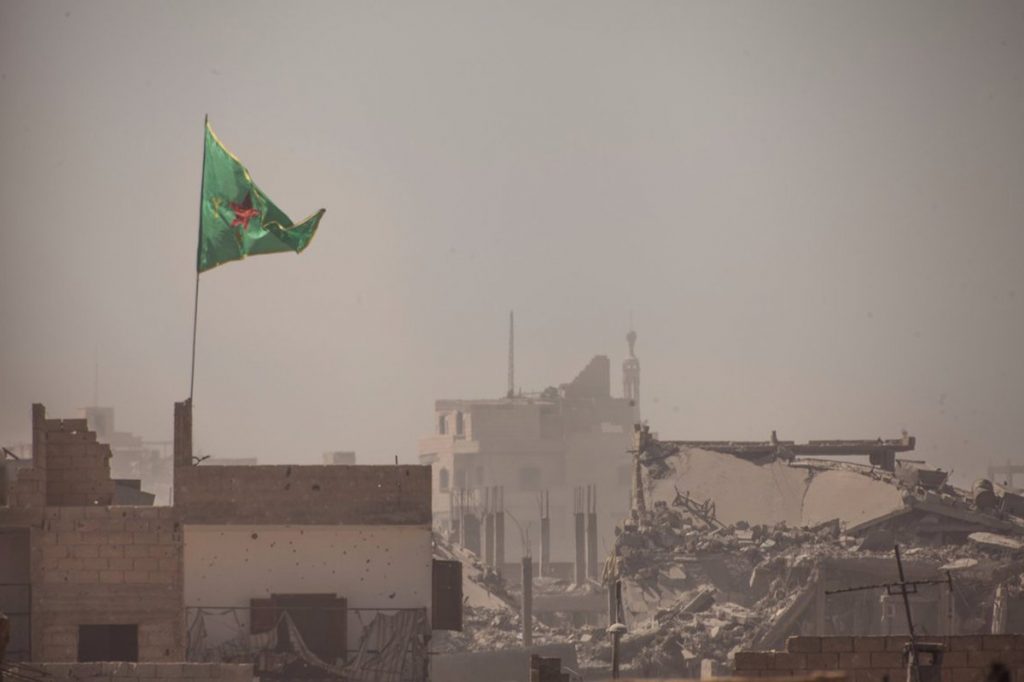
A Kurdish Women’s Defense Units (YPJ) flag flies over Raqqa.
The Islamic State continues to lose ground inside Syria, with separate coalitions seizing turf from the self-declared caliphate in both northern and eastern Syria. The US-backed coalition has slowly pushed its way through the city of Raqqa, which was the Islamic State’s first capital. Meanwhile, the Syrian regime and its allies are attempting to retake the city of Deir Ezzor and its surrounding areas.
Combined Joint Task Force – Operation Inherent Resolve (CJTF-OIR) announced on Sept. 4 that fighters operating as part of the Syrian Democratic Forces (SDF) seized and cleared the Old City of Raqqa, including the Great Mosque. CJTF-OIR touted the gains as “a milestone in the ongoing battle to defeat ISIS in Raqqa and all of Syria.”
The battle for the Old City took approximately two months. The SDF entered the neighborhood in early July, but quickly ran into stiff resistance.
The Islamic State used the Rafiqah Wall, a historic barrier dating back to the 8th Century Abbasid caliphate, as a defensive fortification. This forced the US-led coalition to blow two holes in the wall, thereby allowing SDF fighters to stream into the Old City. CJTF-OIR emphasized at the time that great care was taken to avoid destroying the entire wall.
The large number of civilians living in Raqqa has slowed the ground campaign as well. CJTF-OIR says the US-backed forces “evacuated thousands of civilians and went to great lengths to limit damage to infrastructure, including to the ancient mosque.”
“The Great Mosque is the oldest mosque in the city and has been under ISIS control since 2014 when the terrorist group captured the city from the people of Syria,” CJTF-OIR said in its statement. “ISIS deliberately and consistently uses protected civilian infrastructure such as schools, hospitals and mosques as headquarters, weapons factories and finance hubs.”
The SDF draws many of its fighters from the Kurdish People’s Defense Units (YPG) and Women’s Defense Units (YPJ). The YPG and YPJ are affiliated with the Kurdistan Workers Party (PKK), a US-designated terrorist organization.
The YPG claims that the SDF’s fighters currently control 14 of Raqqa’s 23 neighborhoods, or more than 60 percent of the city, with operations continuing in the remaining nine neighborhoods. The YPG also claims that more than 1,200 Islamic State jihadists were killed in August. In addition, 28 vehicle-borne improvised explosive devices (VBIEDs) were reportedly destroyed before reaching their targets. Abu Bakr al Baghdadi’s organization has deployed hundreds of VBIEDs during its defenses of Mosul and Raqqa, but dozens of the explosive-laden cars and trucks have been taken out before they could do any damage.
As in past battles, the YPG has promoted its role in the fight for Raqqa on social media. The images include photos of YPG and YPJ flags flying over captured ground, as well as videos of Kurdish forces leading civilians to safety. The YPG has also promoted its foreign fighters. Several photos document a ceremony held in New York to commemorate an American who died fighting for the YPG in the so-called caliphate’s stronghold.
Separately, Bashar al Assad’s regime, backed by the Iranians and Russians, claims to have broken the Islamic State’s siege on the eastern city of Deir Ezzor. The two sides have clashed in and around Deir Ezzor since mid-2014, with Abu Bakr al Baghdadi’s loyalists laying siege to the regime’s positions. The Islamic State has produced a steady stream of propaganda from the fighting in Deir Ezzor, including numerous videos of captured soldiers from the Syrian Arab Army (SAA).
In January, the Islamic State launched a new offensive against Assad’s forces in Deir Ezzor, effectively cutting their positions into two. The assault further exacerbated the ongoing humanitarian crisis in Deir Ezzor, according to the United Nations.
However, the SAA has received a boost from Iranian-sponsored militiamen and other irregulars, as well as Russian forces, in recent weeks. This has allowed the the SAA to make new advances in the area.
As Abu Bakr al Baghdadi’s men lost ground in both Iraq and Syria over the course of the past year, key leadership figures, including those involved in planning attacks in the West, have relocated to Deir Ezzor province. The US has carried out a series of airstrikes targeting Islamic State operatives in the towns and villages surrounding the city. This leadership attrition may have indirectly aided the Assad regime’s own drive to retake the area.
Iran is keenly interested in securing eastern Syria as part of a corridor connecting the country to Iraq, where thousands of additional Iranian-sponsored fighters are stationed. But the Iranians also have an interest in simply helping Assad retake Deir Ezzor, a provincial capital that has not been controlled by the Syrian regime for years.








1 Comment
Will there be an American, Kurdish, friendly Sunni line in place to block the Iranians?